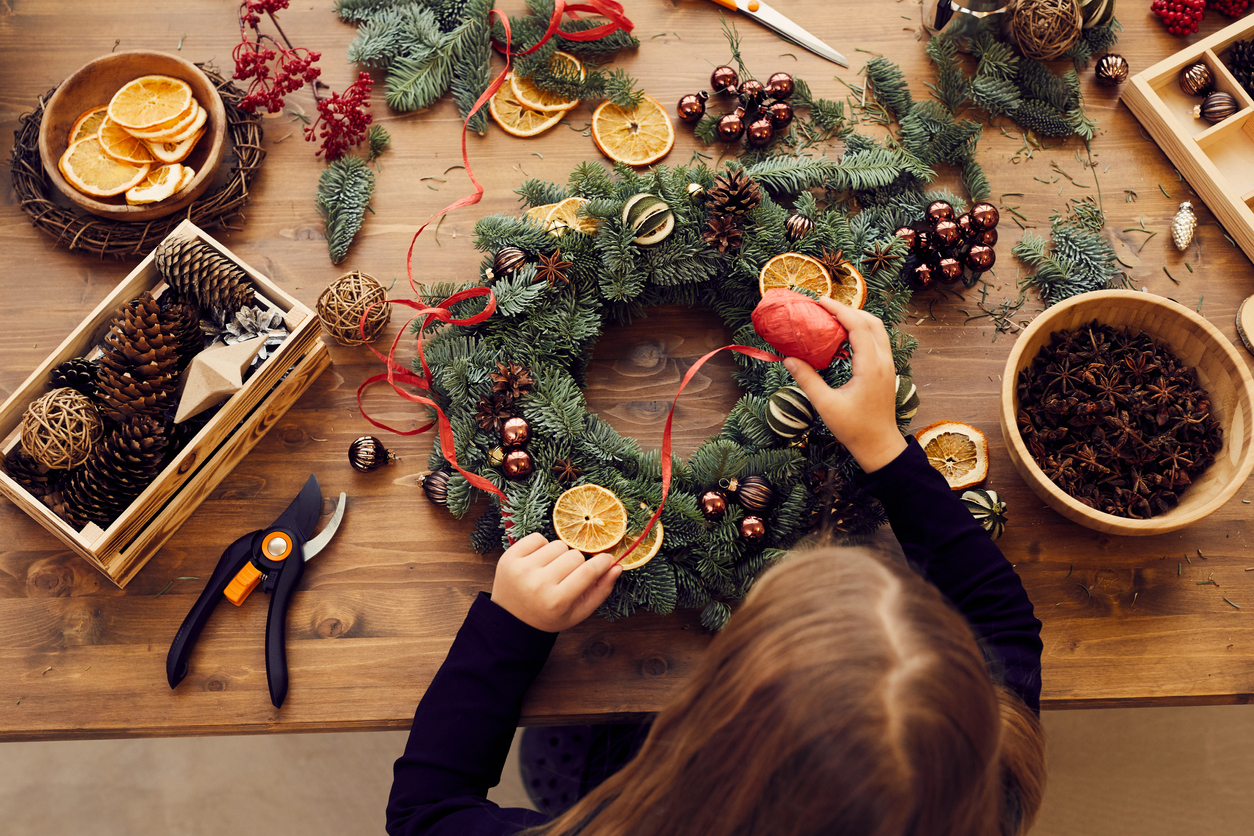From disinfectant properties to caffeine content, Dr Des Corrigan uncovers some lesser-known facts about the Christmas wreath/
Over the years, I have based my December article on a seasonal theme, covering spices and herbs used in Christmas cooking, Christmas flowers and cocktails, among other items.
This year, my choice is the Christmas wreath. Now, I am not talking about artificial ones, but those hand-crafted from natural materials. I am also not suggesting that you attempt to consume your wreath, although some of the plant materials used to create and decorate it are indeed edible. Some of the linkages are, I admit, a little tenuous but no more so than the average plot line in a pantomime!
The basis of most wreaths is likely to be some form of conifer, possibly off-cuts from Christmas trees such as fir (Abies), spruce (Picea) or pine (Pinus). The needles of these contain pleasant-smelling essential oils characteristic of Christmas trees. These oils are all powerful disinfectants, with many of them active against food-borne pathogens such as E.coli, Campylobacter jejunii and Enterococcus faecalis. My main interest is in the materials such as holly, cinnamon sticks and oranges studded with cloves, used to decorate the basic wreath.
The common European holly is Ilex aquifolium, prized for its dark red berries. Those berries, however, can cause vomiting and diarrhoea in children, in whom over 20 berries can be fatal. Intriguingly, according to Wikipedia, the berries contain small amounts of caffeine and theobromine, but the main caffeine-containing ‘holly’ species comes from South America in the form of Maté or Yerba Maté.
Maté is prepared from the leaves of Ilex paraguariensis by roasting over an open fire at 250-5550 C for several minutes. The tea, highly popular in South American countries such as Argentina, is then made with hot water. The rituals surrounding the making of Maté tea are socially important in South America. Remarkably, twice as much Maté is used in Uruguay (10 kg per head per year) than in Argentina, the two countries with the highest consumption.
The processed leaves contain between 1-2 per cent caffeine, up to 0.9 per cent of theobromine, but little or no theophylline. A typical cup of Maté tea has roughly the same amount of caffeine (78mg) as a cup of coffee. Because of a high polyphenol content (17 per cent), the leaves have been investigated for their antimicrobial, antioxidant, anti-obesity and anti-diabetic properties. Human studies show effects on lipid metabolism during exercise. The EMA has published a Community Herbal Monograph (CHM) on Maté, describing it as a “traditional herbal medicinal product for symptoms of fatigue and sensation of weakness”.
A second indication is “to increase the amount of urine to achieve flushing of the urinary tract as an adjuvant in minor urinary complaints”. There have been safety concerns raised about Maté because of the development of carcinogenic polycyclic aromatic hydrocarbons (PAHs) during the drying/roasting process. A Uruguayan study from 1990 drew attention to an increased risk of oesophageal cancer in men who drank more than 2.5 litres of the tea daily. As in much of life, moderation is the key.
The smell of cinnamon bark is the essence of Christmas to me. Not surprisingly, it is a key decorative for wreaths in the form of Cinnamon ‘sticks’ that are actually pieces of bark wrapped inside one another, not unlike a tobacco cigar. The classic odour is due largely to cinnamaldehyde, but some eugenol also contributes to the smell. Medicinally, most attention has focused on the use of the bark in diabetes and the large number of RCTs have featured in numerous systematic reviews and meta-analyses of cinnamon’s effects on diabetes markers, plasma triglyceride and cholesterol levels.
Despite many positive findings in reviews published between 2016 and 2020, the EMA assessor deemed the bark insufficiently effective to justify modifying the CHM. This describes cinnamon as a THMP for symptomatic treatment of mild spasmodic gastrointestinal complaints, including bloating and flatulence. Not a bad thing to have around at this time of year for sure, but still I believe that there is more to cinnamon than the narrow EMA indication.
It is also strange, given the EMA indication, that the most frequently cited adverse events listed in a 2019 review in Clinical Nutrition were GIT disorders, as well as self-limiting allergic reactions. Bizarrely, the authors of this study refer to the safety of cinnamon as a spice, but note that significant adverse events may be associated with its medicinal use. I would have thought that overall exposure levels are likely to be greater for food use compared to medicinal use for short periods.
Cinnamon and clove (another spice I associate with Christmas) both have the compound eugenol in their respective essential oils, though amounts are far greater in cloves. Clove oil is traditionally used for inflammations of the oral and pharyngeal mucosa and for topical anaesthesia in dentistry. It has antimicrobial activity against a number of periodontal pathogens, and analgesic effects in rats and mice linked to a capsaicin-like effect on Substance P.
Clove powder had similar anaesthetic properties to benzocaine when applied to buccal mucosa in adult volunteers. Despite this, the EMA decided not to prepare a CHM for clove because no single-ingredient product containing cloves was available on the market.
Christmas wreaths often have oranges studded with cloves as a decoration. Most of the time, these are sweet oranges from the hybrid Citrus X sinensis. Medicinally, all one can say about them is that they are a useful source of vitamin C. A more interesting orange is the Seville or marmalade orange, also known as ‘bitter orange’. This is the Citrus X aurantium subspecies amara, used in herbal medicine because of its stimulant and appetite suppressant effects, linked to the presence of synephrine.
Used as a replacement for ephedra in herbal weight loss supplements in the US, there is controversy
about its safety. Case reports have linked it to cases of stroke, myocardial infarction, angina and ischaemic colitis, whereas a number of industry-supported reviews report no health concerns with either bitter orange extract or p-synephrine.
More interestingly, given the time of the year, the oil from bitter orange peel is the basis of liqueurs such as Grand Marnier, Triple Sec, Cointreau and Curaçao. At one time, the height of festive sophistication was the box of liqueur-filled chocolates opened in time for either the Maureen Potter or Morecambe and Wise Christmas Special, with everyone hoping to avoid those containing Kirsch.
Nowadays, sophistication comes in the form of one’s choice of liqueur-based cocktail. That might be a B-52 (beloved of some previous generations of pharmacy students) based on Grand Marnier or a Cosmopolitan or Margarita based on Cointreau, or the Triple Sec-based Singapore Sling or Mai Tai.
If any or all of these are your festive drinks of choice, then enjoy them and the holiday break. God knows you and your colleagues deserve it after the past 18 months.
Wishing you a peaceful and pandemicfree Christmas and New Year
CONTRIBUTOR INFORMATION

Dr Des Corrigan, Best Contribution in Pharmacy Award (winner), GSK Medical Media Awards 2014, is a former Director of the School of Pharmacy at TCD and won the Lifetime Achievement Award at the 2009 Pharmacist Awards. He was chair of the Government’s National Advisory Committee on Drugs from 2000 to 2011. He currently chairs the Advisory Subcommittee on Herbal Medicines and is a member of the Advisory Committee on Human Medicines at the IMB. He is a National Expert on Committee 13B (Phytochemistry) at the European Pharmacopoeia in Strasbourg and he is an editorial board member of the Journal of Herbal Medicine and of FACT — Focus on Alternative and Complementary Therapy.







